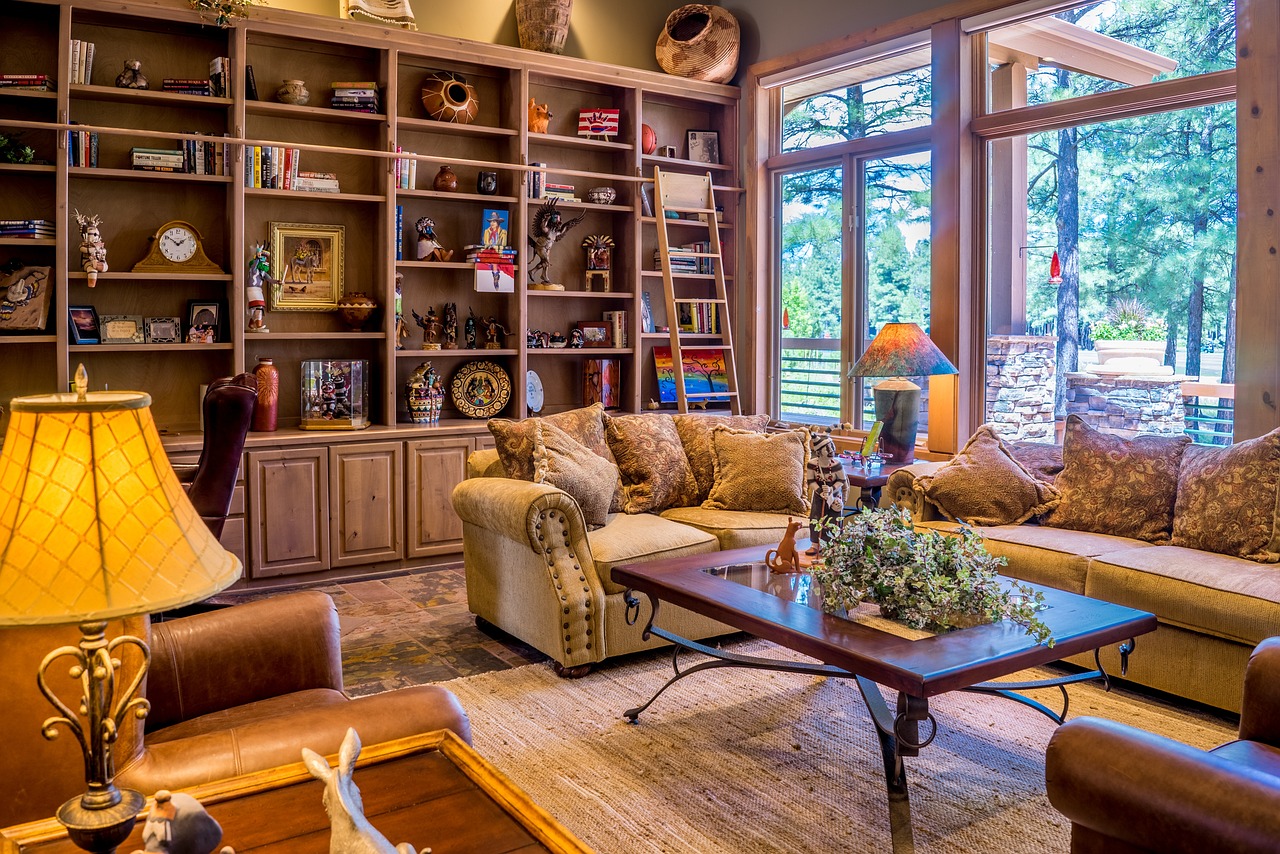Introduction
Your living room is the heart of your home—a place where you unwind, entertain, and create lasting memories. To make this space truly inviting, it’s essential to transform it into a cozy retreat where comfort meets style. In this article, we’ll explore some valuable tips to help you design a comfortable living room that exudes warmth and hospitality.
Your living room is more than just a physical space; it’s the emotional nucleus of your home—a sanctuary where you escape the chaos of the world and embrace the warmth of familiarity. It’s a canvas where you paint memories with friends and family, sharing laughter and stories. To truly honor this vital room, consider it as more than mere aesthetics; it’s about crafting an experience, a haven of comfort and style that welcomes all who enter.
Begin with the fundamentals of comfort. Invest in plush, inviting furniture that beckons you to sink in and unwind. Oversized, sink-in sofas and armchairs not only provide physical relaxation but also signal a mental shift from the demands of the outside world to the tranquility of your home.
Consider the role of textiles in creating a cozy ambiance. Soft, luxurious throws and cushions can transform even the most austere spaces into inviting nooks. Choose warm, earthy tones or soft pastels to evoke a sense of serenity. Texture also plays a crucial role—incorporate fabrics like velvet or faux fur for added tactile comfort.
Lighting sets the mood. Opt for a combination of ambient, task, and accent lighting. Dimmable fixtures allow you to tailor the ambiance to different occasions. Soft, warm light exudes a welcoming glow, making everyone feel at ease.
Personalize your space with artwork and decor that resonates with your personality. Family photos, artwork collected over the years, and treasured mementos inject your living room with character and tell the story of your life.
Maximize functionality without sacrificing style. Incorporate clever storage solutions to keep clutter at bay, ensuring a serene environment. Consider multifunctional furniture pieces, such as coffee tables with hidden compartments or ottomans that double as storage.
Bring nature inside. Houseplants not only purify the air but also add a touch of serenity. A strategically placed indoor garden or a collection of potted plants can infuse life into your living room.
Lastly, foster an atmosphere of hospitality. Arrange seating to facilitate conversation and interaction. Create cozy corners with reading nooks, board games, or a well-stocked bookshelf to encourage relaxation and engagement.
In conclusion, your living room is a canvas where you paint the story of your life. By embracing comfort, style, and personal touches, you can transform it into a welcoming retreat that radiates warmth and hospitality—a space where cherished memories are woven into the very fabric of your home.
For a comprehensive look at this subject, we invite you to read more on this dedicated page: Discover the Charm of North Hart Run: Your Guide to Centreville …
Choose the Right Furniture
Selecting the right furniture is crucial for creating a cozy living room. Opt for comfortable seating arrangements like plush sofas, armchairs, and cozy sectionals. Consider the size of your room and arrange furniture to facilitate conversation while ensuring there’s enough space to move around comfortably.
When it comes to crafting a welcoming and comfortable living room, your choice of furniture sets the tone for the entire space. Let’s explore some additional tips and considerations for selecting and arranging the right furniture:
Quality Matters: Invest in well-constructed furniture pieces. Quality sofas and chairs not only provide comfort but also stand the test of time, ensuring that your living room remains inviting for years to come.
Fabric and Texture: Choose upholstery fabrics that not only match your style but also align with your lifestyle. If you have pets or young children, consider durable and easy-to-clean fabrics. Texture also plays a significant role; mixing materials like leather, velvet, and cotton can add depth and visual interest.
Modular and Versatile: Modular furniture, such as sectionals with interchangeable components, offers flexibility in arranging your living room. You can adapt the configuration to suit various occasions, whether it’s a cozy movie night or a lively gathering with friends.
Coffee and Side Tables: Coffee tables and side tables are not just practical; they’re also design elements. Opt for tables that complement your furniture and provide surfaces for drinks, snacks, and decorative accents like books and vases.
Storage Solutions: Consider furniture pieces with built-in storage. Ottomans with hidden compartments, entertainment centers with shelves, and sideboards can help keep your living room organized and clutter-free.
Balance and Symmetry: Achieving balance in your furniture arrangement is essential. If you have a large sofa on one side of the room, balance it with an equally substantial piece on the opposite side, such as a matching armchair or a bookcase. Symmetry can create a harmonious and visually pleasing layout.
Rugs and Carpets: Area rugs can define specific areas within your living room, such as a seating arrangement or a reading nook. They add warmth, color, and texture to the space. Ensure that the rug’s size is proportional to the room and furniture.
Lighting: Incorporate various lighting sources, including floor lamps, table lamps, and overhead lighting. These elements not only provide illumination but also contribute to the ambiance and mood of the room.
Personal Touches: Don’t forget to infuse your personality into the space. Add throw pillows, blankets, artwork, and decorative accents that reflect your style and interests. These personal touches can make your living room feel uniquely yours.
Flow and Pathways: Maintain clear pathways through your living room to ensure easy movement. Avoid overcrowding the space with too much furniture, as it can make the room feel cramped and uncomfortable.
Scale and Proportion: Consider the scale of your furniture in relation to the room. Large pieces may overwhelm a small space, while petite furniture may get lost in a spacious area. Aim for a harmonious balance.
Seasonal Updates: Consider how your furniture choices can adapt to seasonal changes. Swapping out lighter, breathable fabrics and bright accents for cozy, warm textiles and deeper tones during the colder months can transform the atmosphere of your living room.
In summary, creating a cozy living room involves a thoughtful combination of furniture selection and arrangement. Pay attention to comfort, quality, and aesthetics while also considering practicality and personal style. By striking the right balance and taking these factors into account, you can design a living room that invites relaxation, conversation, and enjoyment for both you and your guests.
Additionally, you can find further information on this topic by visiting this page: Creating a Cozy Retreat: Basement Ideas for a Relaxing Family Room

Soft, Inviting Textiles
Incorporate soft and inviting textiles to enhance the comfort factor. Throw pillows and blankets in complementary colors and patterns can instantly make your living room feel cozier. Consider materials like velvet, fleece, or knits for that warm and tactile sensation.
Incorporating soft and inviting textiles is a key element in creating a cozy living room that beckons you to relax and unwind. The strategic use of throw pillows and blankets in complementary colors and patterns can work wonders in instantly transforming your space into a warm and inviting sanctuary.
1. Pillow Talk:
When selecting throw pillows, think beyond aesthetics. While choosing complementary colors and patterns is essential for visual appeal, it’s equally important to consider the texture and feel of the fabrics. Opt for materials like plush velvet for a touch of luxury, soft fleece for warmth, or knitted textures for that tactile sensation that invites you to sink in and get comfortable. These materials not only look appealing but also add a layer of sensory comfort.
2. Mix and Match:
Creating a cozy atmosphere often involves layering different textures and materials. Don’t be afraid to mix and match pillow and blanket fabrics. A combination of velvet and faux fur pillows, for example, can add depth and dimension to your seating area. Experimenting with various textures not only enhances the tactile experience but also adds visual interest to your living room.
3. Seasonal Switch-Up:
Consider changing your throw pillows and blankets seasonally to match the changing weather. In the colder months, opt for thicker, warmer materials like fleece and cable-knit blankets in rich, deep colors. As spring and summer arrive, switch to lighter, breathable fabrics like cotton and linen in cheerful pastel hues. This simple rotation not only keeps your living room feeling fresh but also aligns with the comfort needs of each season.
4. Personalized Comfort:
Your choice of throw pillows and blankets is an opportunity for personalization. Select patterns and colors that resonate with your style and preferences. Incorporate designs that tell a story or evoke cherished memories. Personalized pillows with monograms or custom embroidery can also add a unique touch to your space, making it feel more like home.
5. Size and Placement:
Consider the size and placement of your throw pillows. Oversized pillows can be especially inviting, providing a plush and supportive surface for relaxation. Arrange pillows in a way that encourages coziness. A well-placed throw blanket draped over the back of a sofa or chair is not only visually appealing but also readily accessible when you want to snuggle up.
6. Maintenance Matters:
To maintain the comfort and freshness of your textiles, regularly wash and fluff your pillows and blankets. Keep an eye out for any signs of wear or fading, as worn-out textiles can detract from the overall coziness of your living room. Investing in high-quality materials can prolong the life of your textiles and ensure enduring comfort.
In conclusion, the use of soft and inviting textiles, such as throw pillows and blankets, is a powerful tool in enhancing the comfort and warmth of your living room. By considering materials, mixing and matching textures, seasonal rotations, personalization, size, and maintenance, you can create a living space that not only looks inviting but also beckons you to snuggle in and savor the comfort it offers.
Additionally, you can find further information on this topic by visiting this page: Creating a Cozy Bedroom Retreat: A Guide to Ultimate Comfort and …

Warm Color Palette
Color plays a significant role in setting the tone for your living room. Earthy tones, warm neutrals, and deep hues like burgundy or forest green can create a welcoming and cozy atmosphere. Experiment with paint, upholstery, and decor to find the perfect color scheme for your space.
Color choices are more than just aesthetics; they can profoundly impact the ambiance and character of your living room. Here are some additional considerations for selecting the ideal color scheme:
Psychological Impact: Colors have psychological effects on mood and perception. Soft blues and greens promote tranquility and relaxation, while vibrant reds and yellows can add energy and warmth. Consider the mood you want to create in your living room and choose colors accordingly.
Natural Light: The amount of natural light in your living room can influence how colors appear. Rooms with ample sunlight can accommodate darker or bolder colors without feeling cramped. In contrast, rooms with limited natural light may benefit from lighter shades to create a sense of airiness.
Size and Layout: The size and layout of your living room can also dictate color choices. Light colors can visually expand a small space, making it feel more open, while dark colors can create a cozy, intimate feel in larger rooms. Consider the proportions and layout of your space when selecting colors.
Complementary Colors: Experiment with complementary colors to add depth and visual interest to your living room. Complementary colors sit opposite each other on the color wheel and can create a dynamic and balanced look. For example, pairing blue with orange or yellow with purple can be visually striking.
Texture and Materials: The texture and material of your furniture and decor can interact with color to enhance the overall aesthetic. For example, a leather sofa in a deep brown hue can complement earthy tones, while a velvet chair in a jewel tone can add a touch of luxury.
Accents and Accessories: Don’t underestimate the impact of accent colors and accessories. Throw pillows, rugs, curtains, and artwork can introduce pops of color into your living room without committing to a full paint job. They also allow you to experiment with different color combinations over time.
Long-Term Satisfaction: Consider the longevity of your color choices. While trendy colors may be appealing now, they can quickly become outdated. Opt for timeless colors for larger, more permanent elements like walls and major furniture pieces, and reserve trendy colors for easily changeable items.
Personal Taste: Ultimately, your living room should reflect your personal taste and style. Choose colors that resonate with you and make you feel comfortable and at ease in your space. Your living room should be a reflection of your personality and preferences.
Testing Samples: Before committing to a color scheme, test paint samples on your walls to see how they look in different lighting conditions throughout the day. This can help you avoid surprises and ensure that you’re happy with your choices.
In summary, the right color scheme can transform your living room into a space that suits your lifestyle, personality, and desired ambiance. Take the time to explore various color options, consider the unique characteristics of your room, and trust your instincts to create a living room that you’ll love coming home to.
For a comprehensive look at this subject, we invite you to read more on this dedicated page: How to decorate a den: 5 tips for the perfect comfort room |

Layered Lighting
Proper lighting is essential for creating a cozy ambiance. Use a combination of ambient, task, and accent lighting. Floor lamps, table lamps, and candles can provide soft, warm illumination. Dimmer switches allow you to adjust the lighting to suit different moods and occasions.
Indeed, proper lighting is not just a practical necessity but a powerful tool for shaping the ambiance of your living room. By carefully considering the interplay of ambient, task, and accent lighting, you can transform your space into a haven of coziness and relaxation.
Ambient Lighting: This serves as the base layer of illumination, providing overall brightness to the room. Consider using overhead fixtures like pendant lights or chandeliers with warm-toned bulbs. To create a welcoming, inviting atmosphere, opt for soft, diffused lighting that eliminates harsh shadows. Frosted glass shades or fabric-covered fixtures can help achieve this effect.
Task Lighting: Task lighting is essential for specific activities like reading, working, or crafting. Place adjustable table lamps on side tables or reading nooks to provide focused illumination. Swing-arm wall sconces are also a stylish and practical choice for task lighting. Ensure that the light source is adjustable to prevent glare and ensure comfort during tasks.
Accent Lighting: Accent lighting adds depth and visual interest to your living room. It’s a way to draw attention to particular elements or areas, such as artwork, decorative objects, or architectural features. Consider track lighting, wall washers, or even recessed lighting with adjustable fixtures to highlight these focal points effectively. Installing dimmer switches for your accent lighting allows you to control the intensity and create a dynamic ambiance.
Floor Lamps and Table Lamps: Floor lamps and table lamps not only serve as functional sources of light but also contribute to your room’s aesthetic. Choose lampshades that diffuse the light gently, casting a warm, inviting glow. You can select lamps that match your decor theme or go for statement pieces that add character to your living room.
Candles: Candles are a timeless addition to any cozy living space. Their soft, flickering light adds a touch of romance and tranquility. Arrange scented candles strategically to infuse your room with soothing fragrances that enhance the overall atmosphere.
Dimmer Switches: Installing dimmer switches for your lighting fixtures is a game-changer when it comes to setting the mood. They allow you to effortlessly transition from bright, well-lit spaces for social gatherings to subdued, intimate settings for a quiet night in. Dimmers grant you full control over the ambiance, making it easy to adapt your living room to different moods and occasions.
In summary, lighting is a fundamental aspect of creating a cozy ambiance in your living room. By combining ambient, task, and accent lighting, along with the flexibility provided by dimmer switches, you can tailor the illumination to suit your preferences and needs. The interplay of soft, warm light from various sources will envelop your space in a warm, inviting aura, making your living room the perfect retreat for relaxation and togetherness.
If you’d like to dive deeper into this subject, there’s more to discover on this page: How to decorate a den: 5 tips for the perfect comfort room |

Personalize with Décor
Personalize your living room with decor that reflects your style and interests. Family photos, artwork, and mementos can add a personal touch and make the space feel like home. Choose decor pieces that resonate with you and contribute to the overall cozy vibe.
Personalizing your living room is not only an opportunity to showcase your individuality but also a way to infuse warmth and character into the space. Here are some additional ideas for personalizing your living room décor:
Gallery Wall: Create a captivating gallery wall featuring a mix of framed family photos, artwork, and even vintage mirrors. This wall can serve as a focal point, telling the story of your life and experiences.
Travel Souvenirs: If you’re an avid traveler, display souvenirs and keepsakes from your journeys. This can include unique trinkets, maps, or even a world globe that serves as both décor and a conversation piece.
Bookshelves: A well-curated bookshelf not only provides storage but also an opportunity to showcase your literary tastes and interests. Organize books by color or theme for an aesthetically pleasing display.
Textiles and Fabrics: Incorporate throw pillows, blankets, and curtains in patterns or colors that resonate with you. Textiles are an easy way to add pops of personality and comfort to your living room.
Plant Life: Incorporate indoor plants or succulents that require minimal maintenance. Plants not only bring a touch of nature indoors but also contribute to a fresh and inviting atmosphere.
DIY Creations: Consider crafting your own art or decorative pieces. DIY projects can be a fun way to express your creativity and add unique touches to your living room.
Collector’s Corner: If you have a collection of items like vintage vinyl records, antique figurines, or even action figures, create a dedicated collector’s corner or display case to showcase your prized possessions.
Personalized Artwork: Commission or create personalized artwork that features your name, initials, or a meaningful quote. These pieces can serve as focal points and add an extra layer of personalization.
Customized Furniture: Invest in custom-made furniture pieces that reflect your taste and style. Whether it’s a bespoke coffee table, handcrafted shelving unit, or a one-of-a-kind accent chair, custom furniture can be a statement of your uniqueness.
Thematic Decor: Design your living room with a specific theme in mind. Whether it’s a vintage-inspired lounge, a coastal retreat, or a mid-century modern haven, choosing a theme can help guide your décor choices and create a cohesive look.
Memorabilia: Display memorabilia from your favorite hobbies or sports teams. This can include signed sports memorabilia, vintage posters, or even a collection of vintage video games.
Lighting with Personality: Choose unique and artistic lighting fixtures that reflect your style. A well-designed pendant light or a quirky floor lamp can serve as both functional and decorative elements.
Remember that personalizing your living room is an ongoing process, and it should evolve with your changing interests and experiences. The key is to surround yourself with items that bring you joy and create a living space that truly feels like home—a place where you can relax, entertain, and connect with loved ones while enjoying the comfort of your personal touch.
For additional details, consider exploring the related content available here Creating a Cozy Bedroom Retreat: A Guide to Ultimate Comfort and …

Greenery and Nature
Bringing a touch of nature into your living room can infuse it with warmth and tranquility. Houseplants not only improve air quality but also add a sense of freshness to your space. Place potted plants strategically around the room to create a harmonious connection with the outdoors.
Bringing a touch of nature into your living room is akin to inviting a slice of the great outdoors into your home—a transformative endeavor that goes beyond mere aesthetics. Houseplants, aside from their visual appeal, serve as dynamic elements that infuse your living space with warmth, tranquility, and vitality.
1. Improved Air Quality:
Houseplants are not just decorative; they also act as natural air purifiers. Many common indoor plants, such as snake plants, spider plants, and peace lilies, are known for their air-purifying qualities. They absorb airborne toxins and release oxygen, creating a healthier and fresher atmosphere within your living room. This not only contributes to your physical well-being but also enhances the overall comfort of your space.
2. Biophilic Connection:
The term “biophilia” refers to humanity’s innate connection to nature. Incorporating houseplants into your living room aligns with this biophilic principle, fostering a deeper connection with the natural world. It’s as if you’ve created a microcosm of nature within your home. This connection can evoke feelings of calmness and serenity, reducing stress and promoting a sense of well-being.
3. Visual Appeal:
The aesthetic benefits of houseplants are undeniable. The lush green foliage, varied shapes, and sometimes vibrant flowers can instantly transform the visual appeal of your living room. Plants add a dynamic element that softens the lines of furniture and decor, creating a sense of balance and harmony. The contrast between the organic forms of plants and the man-made elements of your living space creates visual interest.
4. Creating Zones:
Strategically placing potted plants around your living room can define and enhance different zones within the space. For instance, a tall, elegant palm plant can delineate a reading nook, while a cascading ivy on a bookshelf can create an inviting corner for contemplation. Using plants in this manner not only adds character to your room but also encourages you to utilize the space more purposefully.
5. A Sense of Responsibility:
Taking care of houseplants instills a sense of responsibility and nurturance. Much like caring for a pet, tending to your plants can be a rewarding and therapeutic experience. It provides a daily ritual that connects you to the living world and fosters a sense of accomplishment as you witness your plants thrive under your care.
6. Versatile Options:
Houseplants come in a multitude of varieties, making it easy to find options that suit your living room’s lighting conditions and your level of gardening expertise. Whether you have ample sunlight or low light, there are plants that can thrive in almost any environment. From low-maintenance succulents to more high-maintenance flowering plants, you can choose species that align with your lifestyle and design preferences.
In summary, introducing houseplants into your living room is a multi-faceted enhancement that goes beyond aesthetics. These natural companions not only improve air quality but also foster a deeper connection to nature, elevate the visual appeal of your space, define zones, nurture a sense of responsibility, and offer versatile options for customization. Ultimately, they infuse your living room with a sense of warmth, tranquility, and vitality, turning it into a serene haven that draws you closer to the natural world.
To expand your knowledge on this subject, make sure to read on at this location: 19 Relaxing Backyard Ideas for a Cozy Retreat

Functional Layout
Keep functionality in mind when designing your living room. Ensure that it serves your needs, whether it’s a space for relaxation, reading, or entertaining. Arrange furniture in a way that maximizes comfort and functionality while maintaining an uncluttered look.
Designing a functional and comfortable living room involves careful planning and consideration of your specific needs and lifestyle. Here are some additional tips to help you create a living room that seamlessly blends both form and function:
Purposeful Layout: Determine the primary function of your living room, whether it’s for family gatherings, movie nights, or a quiet reading nook. Arrange furniture to accommodate this function as the focal point. For example, if it’s a space for TV watching, ensure that seating is oriented toward the screen.
Traffic Flow: Keep traffic flow in mind to prevent the room from feeling cramped or disjointed. Arrange furniture in a way that allows for easy movement between seating areas and access to doors and windows. Consider creating defined pathways within the room.
Multifunctional Furniture: Invest in multifunctional furniture pieces to maximize space and utility. Sofas with built-in storage, coffee tables that can double as desks, and ottomans with hidden storage are great options for optimizing your living room’s functionality.
Flexible Seating: Choose seating options that can be easily rearranged to adapt to different activities and group sizes. Modular sofas or chairs with lightweight designs allow for flexibility in seating arrangements.
Organization and Storage: Incorporate ample storage solutions to keep the living room clutter-free. Cabinets, shelving units, and built-in storage can help you organize books, media, toys, and other items. This not only enhances functionality but also maintains a tidy appearance.
Lighting Design: Pay attention to lighting to create the right ambiance and functionality. A combination of ambient, task, and accent lighting can cater to various activities. Floor lamps, table lamps, and dimmable fixtures provide flexibility in adjusting lighting levels.
Technology Integration: If your living room is a hub for entertainment, consider integrating technology seamlessly. Concealed wiring and outlets, as well as designated areas for electronic devices, can contribute to a clean and organized look.
Comfortable Seating: Prioritize comfort when selecting seating options. Cushioned sofas and chairs with ergonomic designs ensure that you and your guests can relax for extended periods. Incorporate cozy throws and pillows for added comfort.
Personal Touches: Infuse your personality into the space with personal touches such as artwork, decorative accessories, and family photos. These elements not only enhance aesthetics but also make the room feel uniquely yours.
Regular Maintenance: Maintain the functionality of your living room by establishing regular cleaning and organization routines. A clutter-free and well-maintained space is more inviting and functional.
Future-Proofing: Consider how your needs may change in the future. Leave room for adaptability and updates to accommodate evolving lifestyle requirements.
Balance Aesthetics: While functionality is paramount, don’t overlook aesthetics. A well-designed living room can enhance your overall well-being and create a pleasant atmosphere.
In conclusion, a functional living room is one that aligns with your lifestyle, facilitates activities, and promotes comfort and convenience. By carefully planning the layout, selecting versatile furniture, and incorporating thoughtful design elements, you can create a living room that not only looks great but also serves as a practical and inviting space for you and your loved ones.
Should you desire more in-depth information, it’s available for your perusal on this page: Scandinavian Living Room: A Guide to Cozy, Minimalist Design

Cozy Fireplace or Hearth
If you have the option, a fireplace or hearth can be the ultimate focal point for a cozy living room. Whether it’s a traditional wood-burning fireplace or a modern gas insert, the warm glow and crackling sound of a fire create a comforting ambiance.
Having a fireplace or hearth in your living room is like having a timeless piece of coziness and charm right at the heart of your home. It’s not just a focal point; it’s an enchanting centerpiece that elevates the entire ambiance, bringing with it a host of sensory delights and a touch of nostalgia.
Warmth and Visual Appeal: The most obvious benefit of a fireplace is the warmth it provides. During colder months, there’s nothing quite like gathering around a crackling fire, feeling the gentle radiating heat on your skin. It becomes a natural gathering point, inviting family and friends to congregate and share stories. Beyond the physical warmth, the visual appeal of dancing flames, flickering embers, and the soft glow they cast on your living room creates a captivating spectacle.
Acoustic Comfort: The gentle crackling and popping sounds of a wood-burning fireplace are not just auditory sensations; they are a form of auditory therapy. These sounds have a soothing effect, helping to reduce stress and promote relaxation. It’s as if the fire is whispering its own story, adding a layer of tranquility to your living space.
Versatile Styles: Fireplaces come in a variety of styles to suit your taste and the overall aesthetic of your living room. Whether you prefer a classic, rustic look with a wood-burning fireplace or a sleek, modern design with a gas insert, there’s a fireplace style that can seamlessly blend into your decor and become a statement piece.
Practicality: Fireplaces are not just for looks; they can be functional sources of heat, potentially reducing your reliance on central heating during the colder months. This can lead to energy savings while adding an extra layer of coziness to your living room.
Mood Enhancer: Fireplaces have an innate ability to enhance the mood and atmosphere of your living space. They can turn an ordinary evening into a romantic one, a simple gathering into a memorable event, and a solitary moment into a reflection of contentment.
Home Value: Beyond personal comfort, a well-maintained fireplace can also add value to your home. It’s a desirable feature for potential buyers and can set your property apart in the real estate market.
Safety and Convenience: Modern fireplaces, especially gas inserts, offer safety features like remote controls and timers. This ensures that you can enjoy the benefits of a fire with ease and peace of mind.
In conclusion, a fireplace or hearth is more than just a focal point in a living room; it’s a symbol of warmth, comfort, and togetherness. Whether it’s the traditional charm of a wood-burning fireplace or the convenience of a gas insert, the presence of a fire creates a captivating ambiance that enhances your living space in both practical and emotional ways. It’s a timeless addition that can make your living room the ultimate retreat for relaxation and connection.
Explore this link for a more extensive examination of the topic: Simple & Cozy Living Room Ideas on a Budget for Winter – Joyful …

Soft Flooring
Soft, comfortable flooring can greatly enhance the cozy feel of your living room. Area rugs in soft materials like wool or shag can add warmth to hardwood or tile floors. Choose a rug that complements your decor and anchors the seating area.
Creating a cozy living room starts from the ground up, quite literally. Your choice of flooring and area rugs can significantly impact the overall comfort and ambiance of the space. Here’s how to make the most of soft and comfortable flooring:
Area Rugs as Cozy Islands: Consider area rugs as islands of coziness within your living room. They not only provide a soft surface underfoot but also define specific areas within the room, such as the seating arrangement or a reading nook. Opt for rugs in materials like plush wool, silky shag, or soft cotton for maximum comfort.
Warmth and Texture: Soft flooring materials not only add warmth but also introduce texture to the room. The tactile experience of walking on a soft rug can enhance the overall sensory appeal of your living space.
Color and Pattern: Area rugs offer an opportunity to introduce color and pattern into your décor. Choose a rug that complements your furniture and color scheme. A well-chosen rug can tie together different elements of the room and create a harmonious look.
Size Matters: Select a rug size that suits the dimensions of your living room. Ideally, the rug should be large enough to accommodate the front legs of your furniture pieces, creating a cohesive and grounded seating area. This arrangement not only enhances comfort but also fosters a sense of togetherness among your furniture.
Layering Rugs: If you have an existing rug or carpet and want to add extra softness, consider layering rugs. Place a smaller, textured rug on top of a larger one to create a visually appealing and multi-dimensional effect.
Maintenance and Cleaning: Keep in mind that soft and plush rugs may require regular maintenance to keep them looking their best. Be prepared for occasional vacuuming and spot cleaning to maintain their appearance and comfort.
All-Season Comfort: Soft flooring isn’t just for winter. It provides year-round comfort. In the summer, a soft rug can feel cool and inviting underfoot, while in the winter, it adds warmth and insulation.
Personalized Style: Choose a rug that reflects your personal style and the overall theme of your living room. Whether you prefer a modern, minimalistic look or a more traditional, ornate design, there’s a rug style to match.
Durability: Consider the durability of your rug, especially if it’s placed in a high-traffic area. Rugs made from natural fibers like wool tend to be more resilient and long-lasting.
Maintenance: Regularly vacuum your rug to prevent dirt and debris from accumulating. Rotate the rug periodically to ensure even wear. If spills occur, address them promptly with appropriate cleaning methods.
In summary, soft and comfortable flooring in the form of area rugs can significantly elevate the coziness of your living room. These rugs not only provide a pleasant surface to walk on but also contribute to the overall aesthetics and comfort of the space. By selecting the right rug in terms of material, size, and style, you can create a living room that invites relaxation and warmth, making it a truly inviting and cozy retreat for you and your guests.
Explore this link for a more extensive examination of the topic: Riverview Carpet | Berber, Pattern, Texture | Homespun Furniture

Regular Maintenance
Lastly, don’t forget to maintain your cozy living room. Regular cleaning and decluttering are essential to keep the space inviting and comfortable. Freshening up textiles and decor as seasons change can also help maintain the cozy atmosphere.
Lastly, don’t underestimate the importance of ongoing maintenance in preserving the cozy ambiance of your living room. Regular cleaning and decluttering are essential habits that go a long way in ensuring your space remains inviting and comfortable throughout the year. Here’s why maintenance is key and some additional tips to keep your living room consistently cozy:
1. Cleaning for Comfort:
Dust and dirt accumulation can quickly detract from the comfort of your living room. Regularly vacuuming carpets and rugs, dusting surfaces, and wiping down furniture can help maintain a clean and inviting atmosphere. Clean windows allow natural light to filter in, enhancing the warmth of your space.
2. Declutter for Serenity:
A cluttered living room can feel chaotic and less inviting. Regularly declutter by tidying up magazines, books, and loose items. Ensure that there’s a designated place for everything, from remote controls to throw blankets. Storage solutions like shelves, cabinets, and decorative baskets can help maintain a clutter-free environment.
3. Seasonal Updates:
To keep your living room feeling fresh and in tune with the changing seasons, consider periodic updates. Swap out throw pillow covers, blankets, and even some decor items to align with the colors and textures of each season. In spring, introduce light and airy fabrics, while autumn may call for richer, warmer tones. These small changes can breathe new life into your space.
4. Upholstery and Carpet Care:
Regularly clean and maintain your upholstery and carpets. Vacuuming and spot cleaning can help extend the life of your furniture and flooring. If your furniture is due for a deep cleaning, consider professional upholstery cleaning services to remove stains and odors, reviving the coziness of your living room.
5. Rotate and Rearrange:
Periodically changing the arrangement of your furniture and decor can lend a fresh perspective to your living room. Experiment with different layouts to see what feels most comfortable and functional. This practice can also help distribute wear and tear on furniture evenly.
6. Keep an Eye on Wear and Tear:
Inspect your furniture and decor for signs of wear and tear. Address any damages promptly, whether it’s a loose chair leg, a fraying area rug, or a malfunctioning heating element in your fireplace. Regular maintenance and repairs ensure that your living room remains a safe and comfortable haven.
7. Personal Touches:
Finally, don’t forget to add personal touches to your living room. Incorporate decor elements that resonate with your style and reflect your personality. Whether it’s artwork, family photos, or sentimental items, these personal touches contribute to the feeling of coziness and make the space uniquely yours.
In conclusion, maintaining your cozy living room is a continuous process that involves cleaning, decluttering, and making seasonal updates. By dedicating time and effort to preserving the inviting and comfortable atmosphere of your living space, you can ensure that it remains a haven of warmth and relaxation for you, your family, and guests to enjoy year-round.
To delve further into this matter, we encourage you to check out the additional resources provided here: Rustic Western Pillows: Create a Cozy Retreat – Southwestern Rugs …

Conclusion
Transforming your living room into a cozy retreat is a rewarding endeavor. By selecting the right furniture, textiles, colors, lighting, and decor, you can create a space that invites relaxation and fosters cherished moments with loved ones. Remember, it’s not just about aesthetics; it’s about cultivating an environment that truly feels like home, where comfort and style coexist harmoniously.
Creating a cozy retreat in your living room is a thoughtful and fulfilling project that can enhance your daily life. Here are some additional considerations to help you achieve a truly inviting and comforting living space:
Texture Variety: Introduce a mix of textures to add depth and tactile appeal to your living room. Incorporate soft, plush fabrics like velvet or faux fur for upholstery and throw pillows. Combine these with natural textures like wood, stone, or rattan for a balanced and cozy feel.
Layered Lighting: Layered lighting is essential for creating a warm and inviting ambiance. Install a combination of overhead lighting, task lighting, and ambient lighting. Dimmer switches allow you to adjust the intensity, setting the mood for different occasions.
Fireplace Focal Point: If you have a fireplace, it can serve as a captivating focal point for your cozy retreat. Arrange seating around the fireplace to create a cozy nook for relaxation and conversation. Consider adding a basket of logs or an electric fireplace for added warmth and charm.
Area Rugs: Large area rugs can define seating areas and add an extra layer of comfort underfoot. Opt for soft, plush rugs in neutral or calming colors to create a warm and inviting foundation for your living room.
Candles and Scents: Scented candles or essential oil diffusers can contribute to a cozy atmosphere. Choose fragrances that evoke feelings of comfort, such as lavender, vanilla, or cinnamon. The soft glow of candles also adds to the overall warmth.
Personalized Decor: Display personal mementos, family photos, and cherished artwork to infuse your living room with sentimental value. These items not only reflect your personality but also create a sense of nostalgia and comfort.
Book Nooks: Create a small reading corner with a comfy chair, a side table, and a well-stocked bookshelf. Having a dedicated space for reading enhances the cozy and inviting feel of the room.
Blankets and Throws: Keep a basket of blankets and throws within easy reach. They are not only functional for staying warm but also add a cozy, inviting aesthetic when casually draped over furniture.
Nature and Greenery: Incorporate natural elements and houseplants into your decor. Greenery not only adds a touch of nature but also purifies the air and contributes to a calming atmosphere.
Mood-Enhancing Colors: Colors can have a profound impact on mood. Consider soothing, muted tones like soft blues, gentle grays, or warm earthy colors to create a tranquil environment.
Soft Furnishings: Invest in high-quality, comfortable furnishings that encourage relaxation. Sink-in sofas and armchairs with ample cushions provide the perfect lounging experience.
Unplug and Disconnect: Create a space where you can disconnect from screens and digital distractions. Designate a cozy corner for unplugged activities like board games, puzzles, or simply enjoying a cup of tea or coffee.
Remember that the key to a cozy retreat is a harmonious balance between aesthetics and comfort. Your living room should be a reflection of your personality and a space where you can unwind, connect with loved ones, and find solace in the midst of everyday life.
Don’t stop here; you can continue your exploration by following this link for more details: The Hygge Bedroom: Transform Your Bedroom into a Cozy Retreat
More links
Additionally, you can find further information on this topic by visiting this page: 24 Rustic Living Room Ideas for a Cozy Retreat
